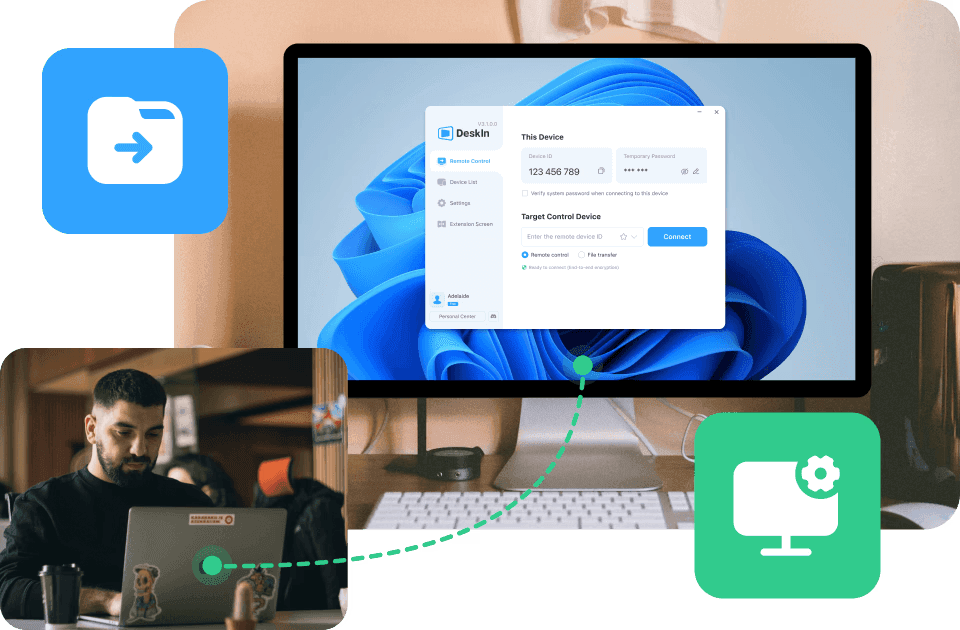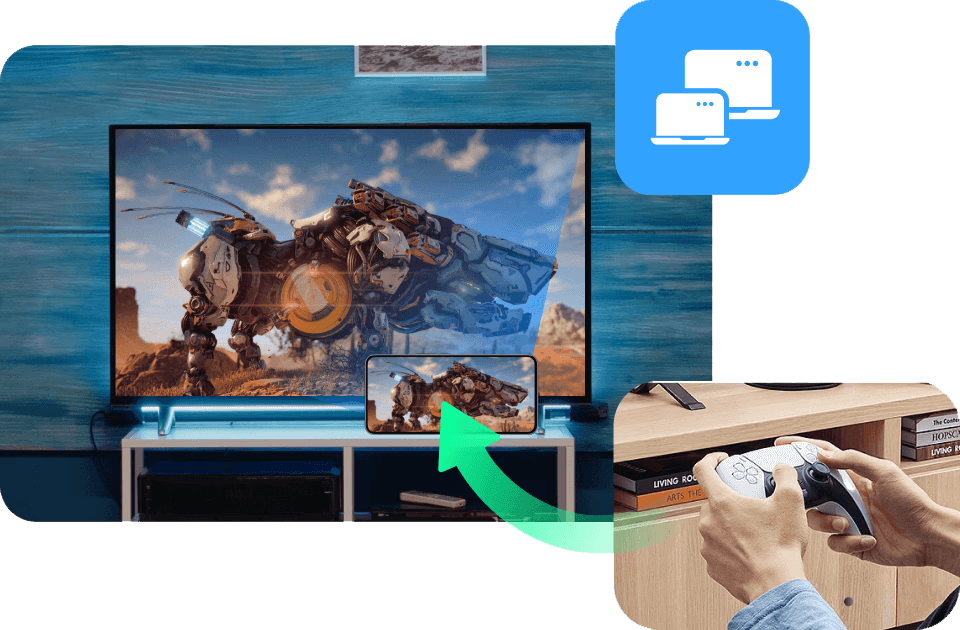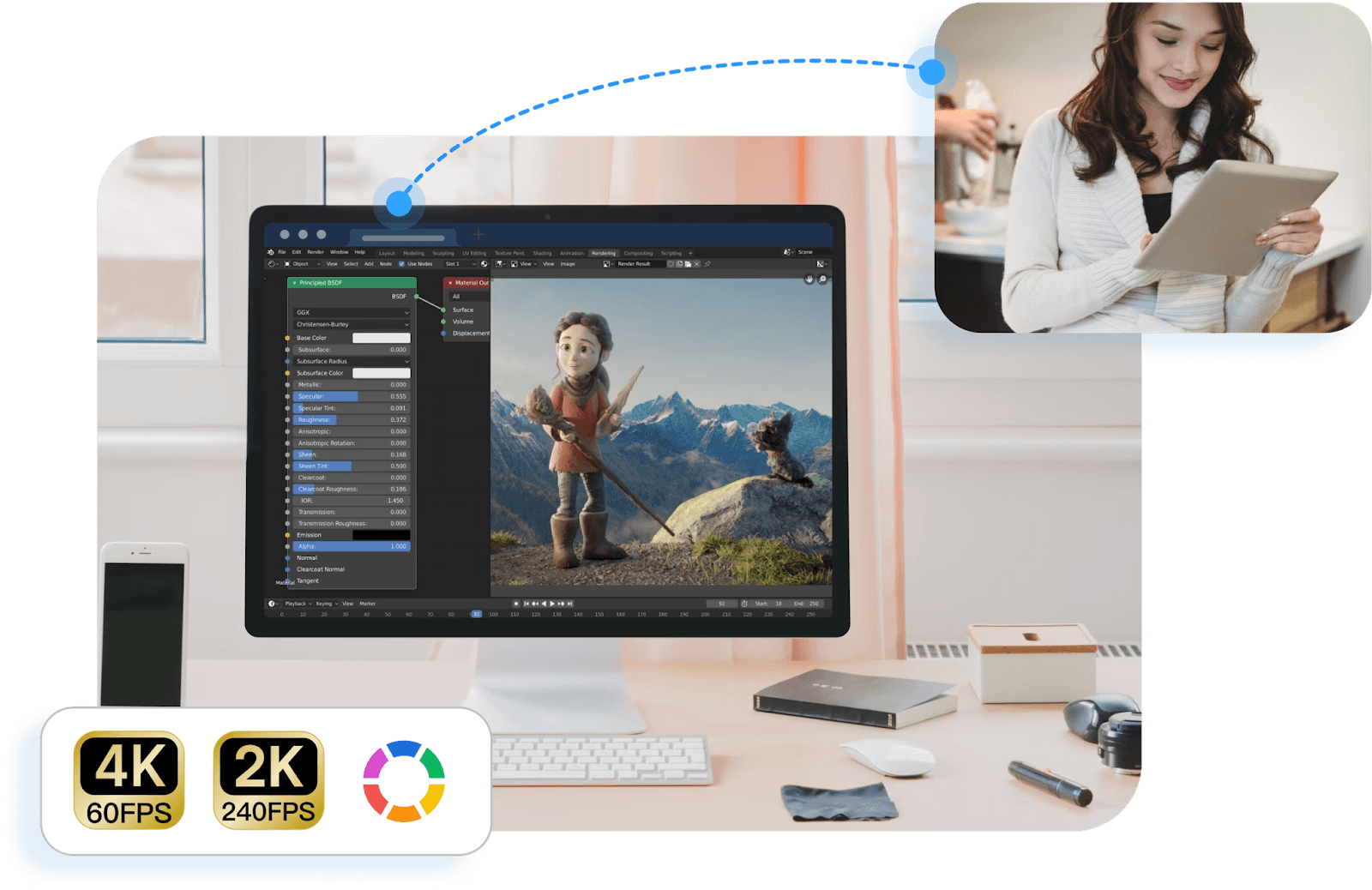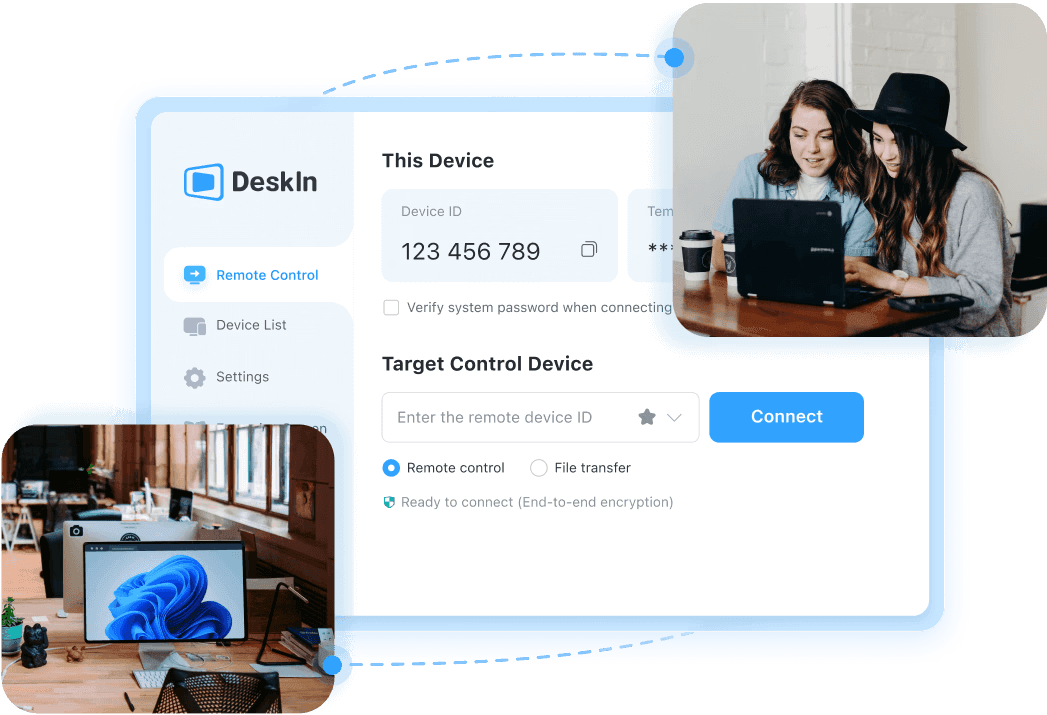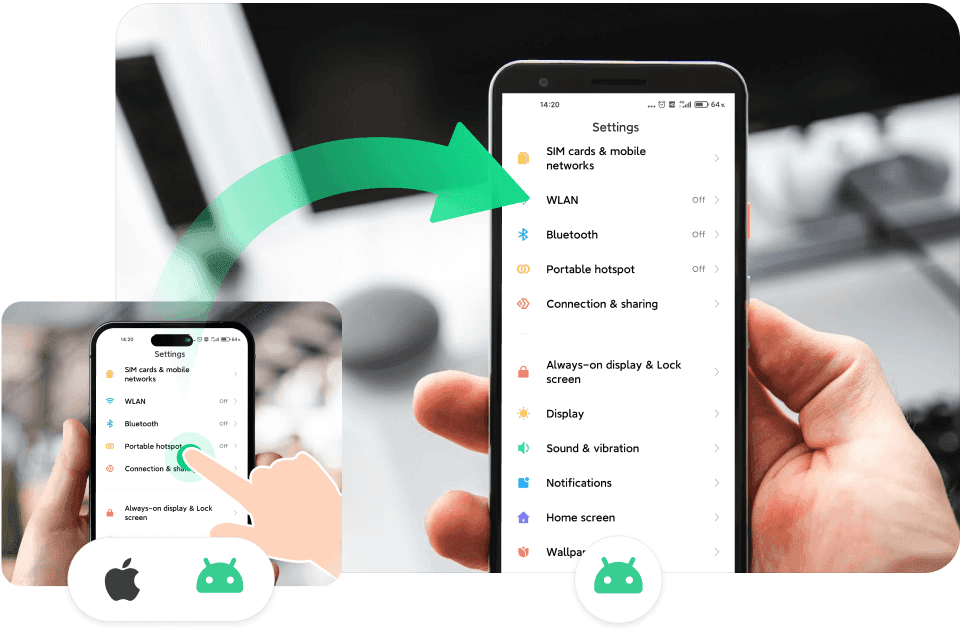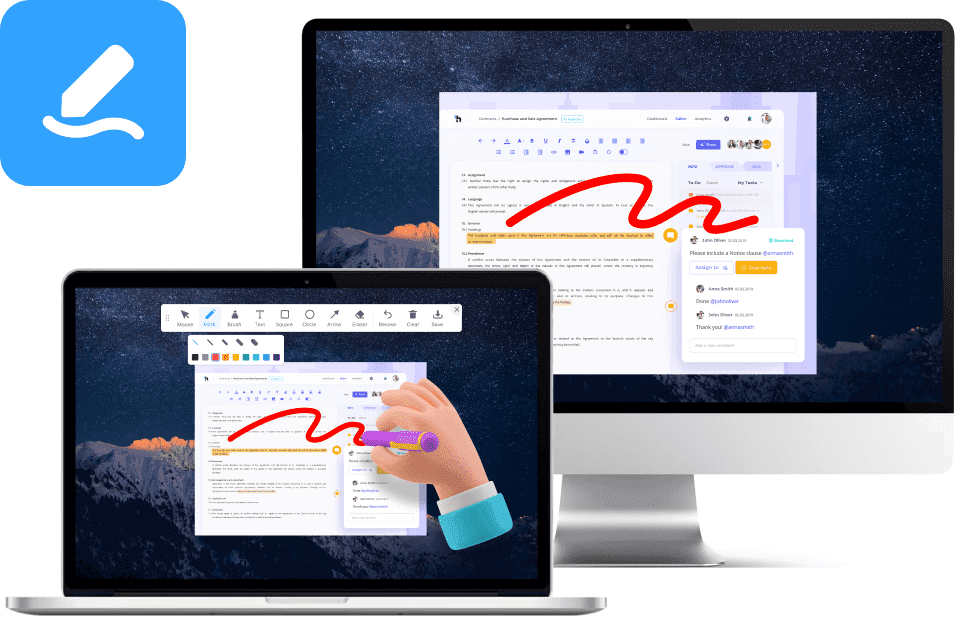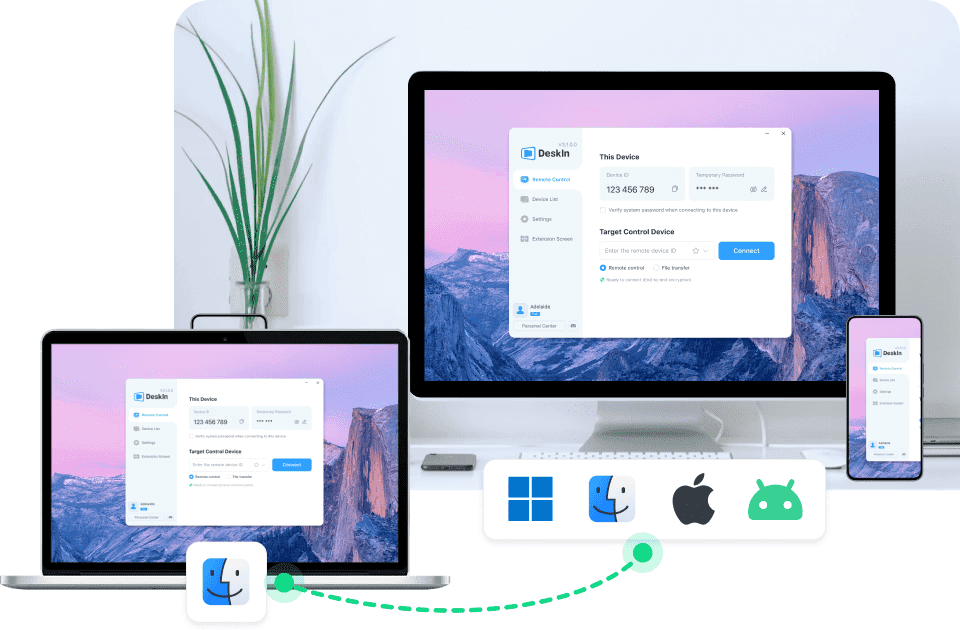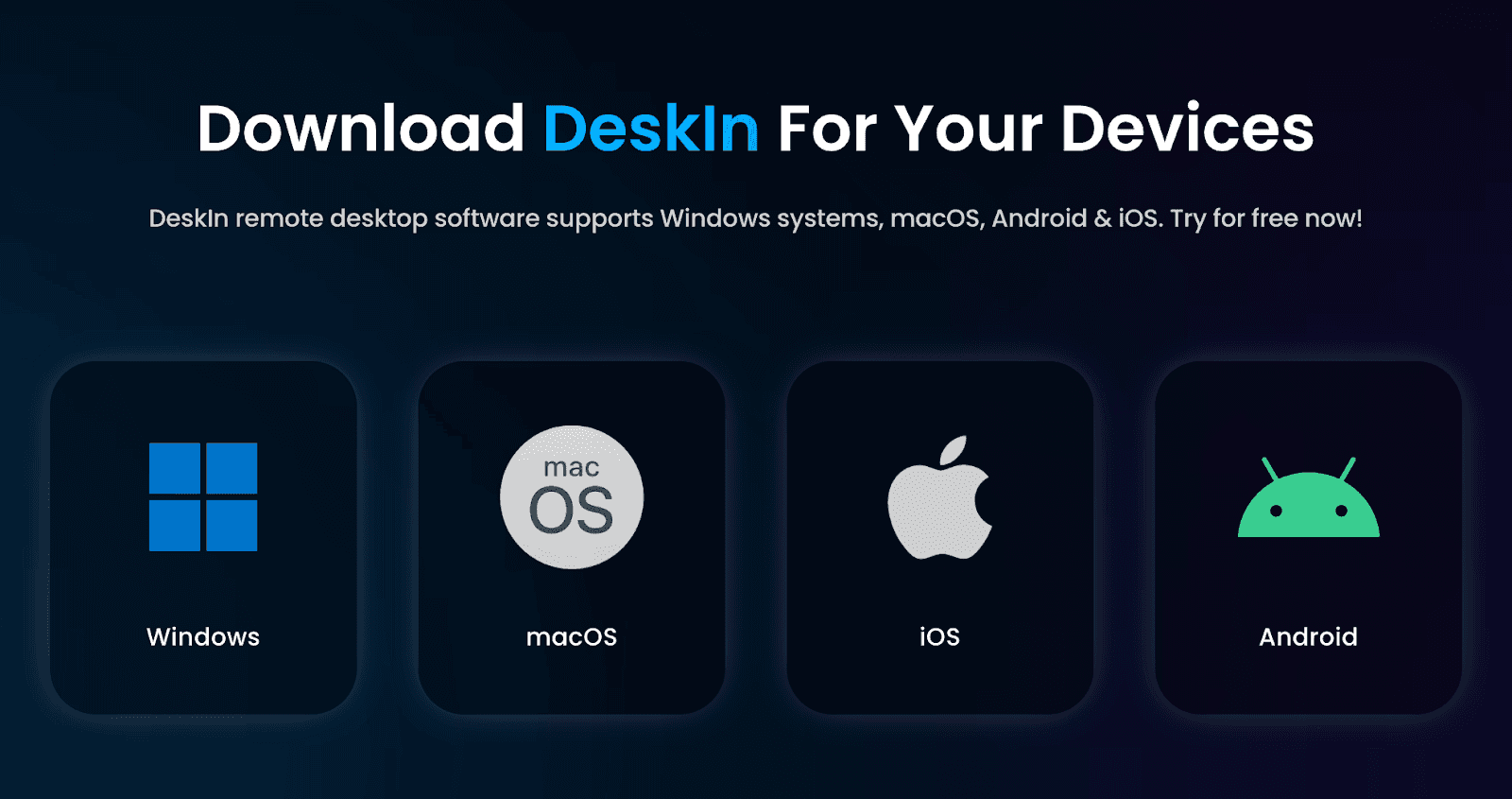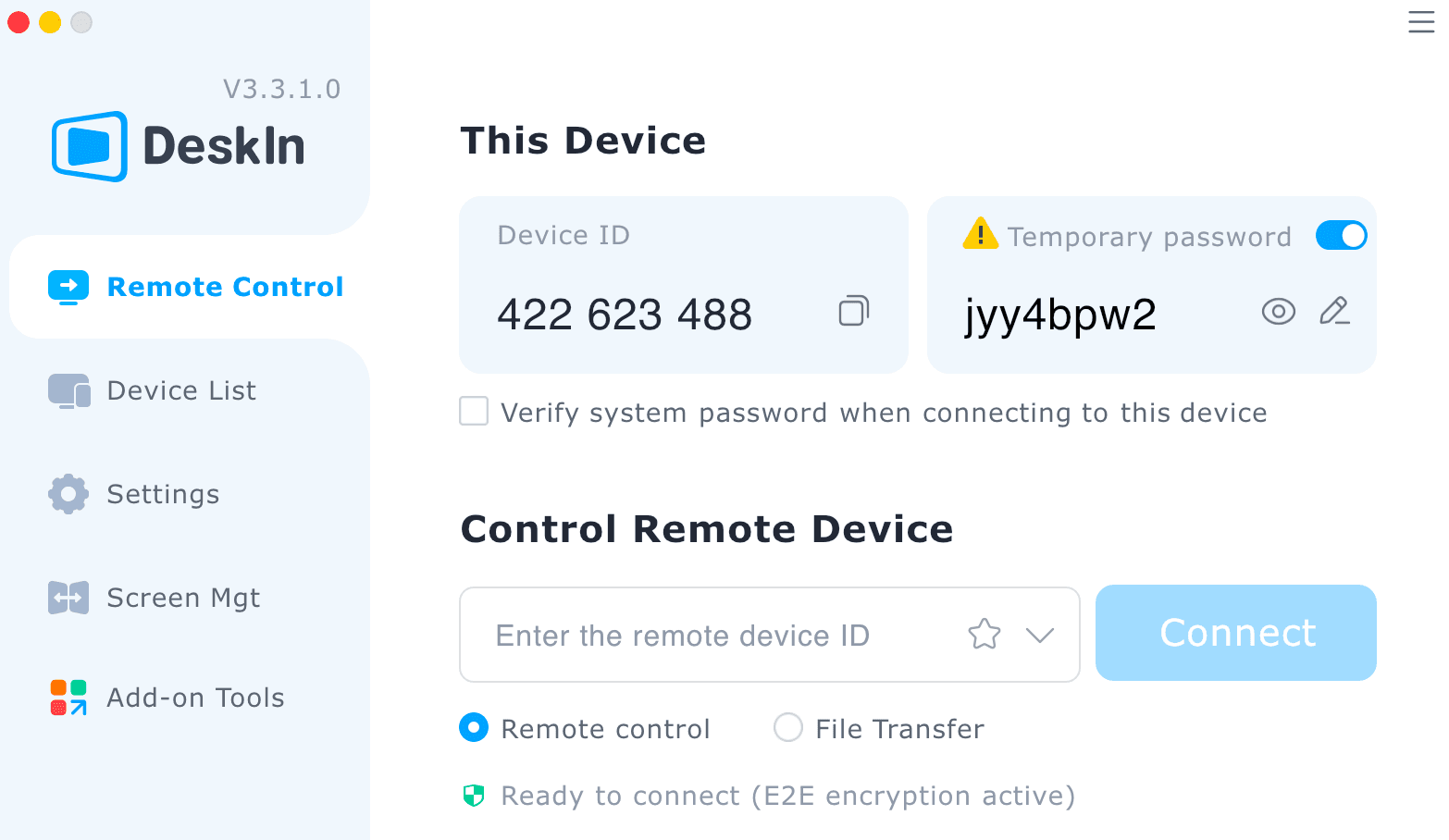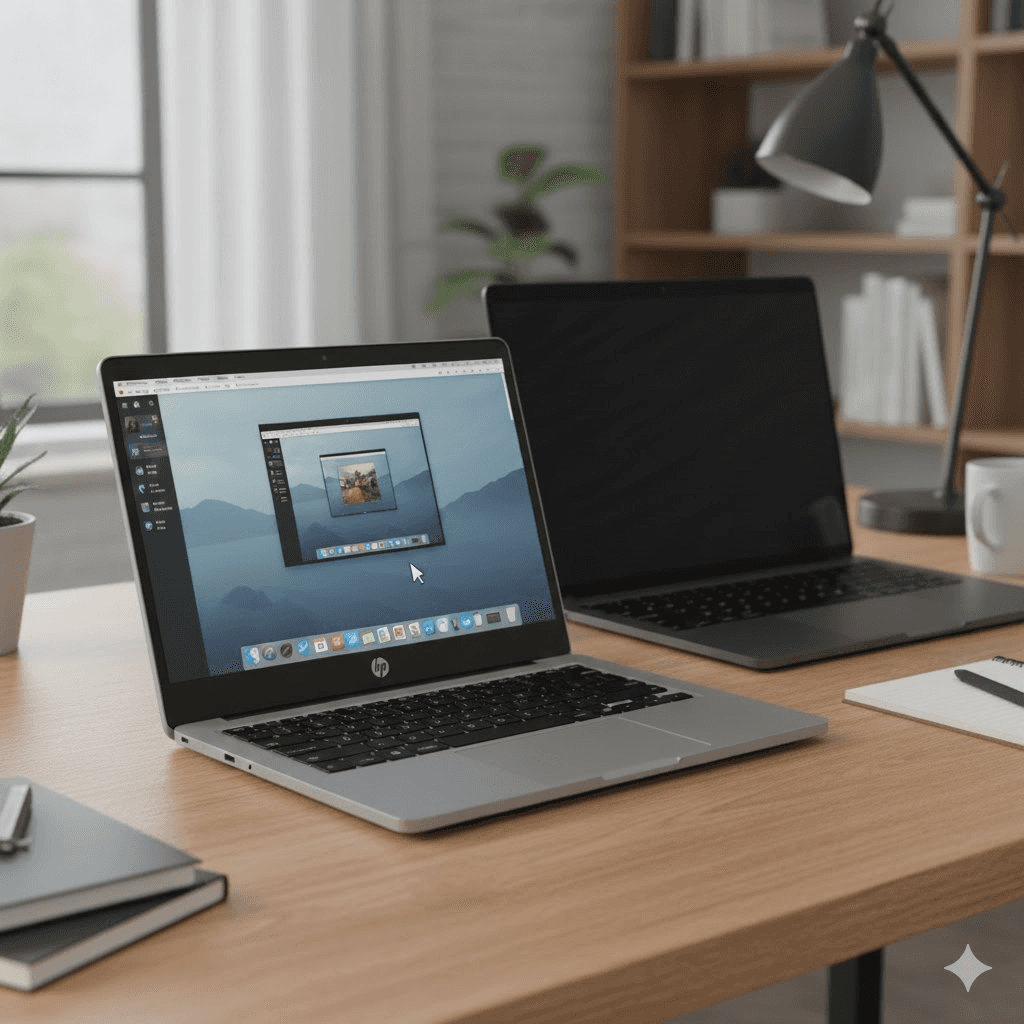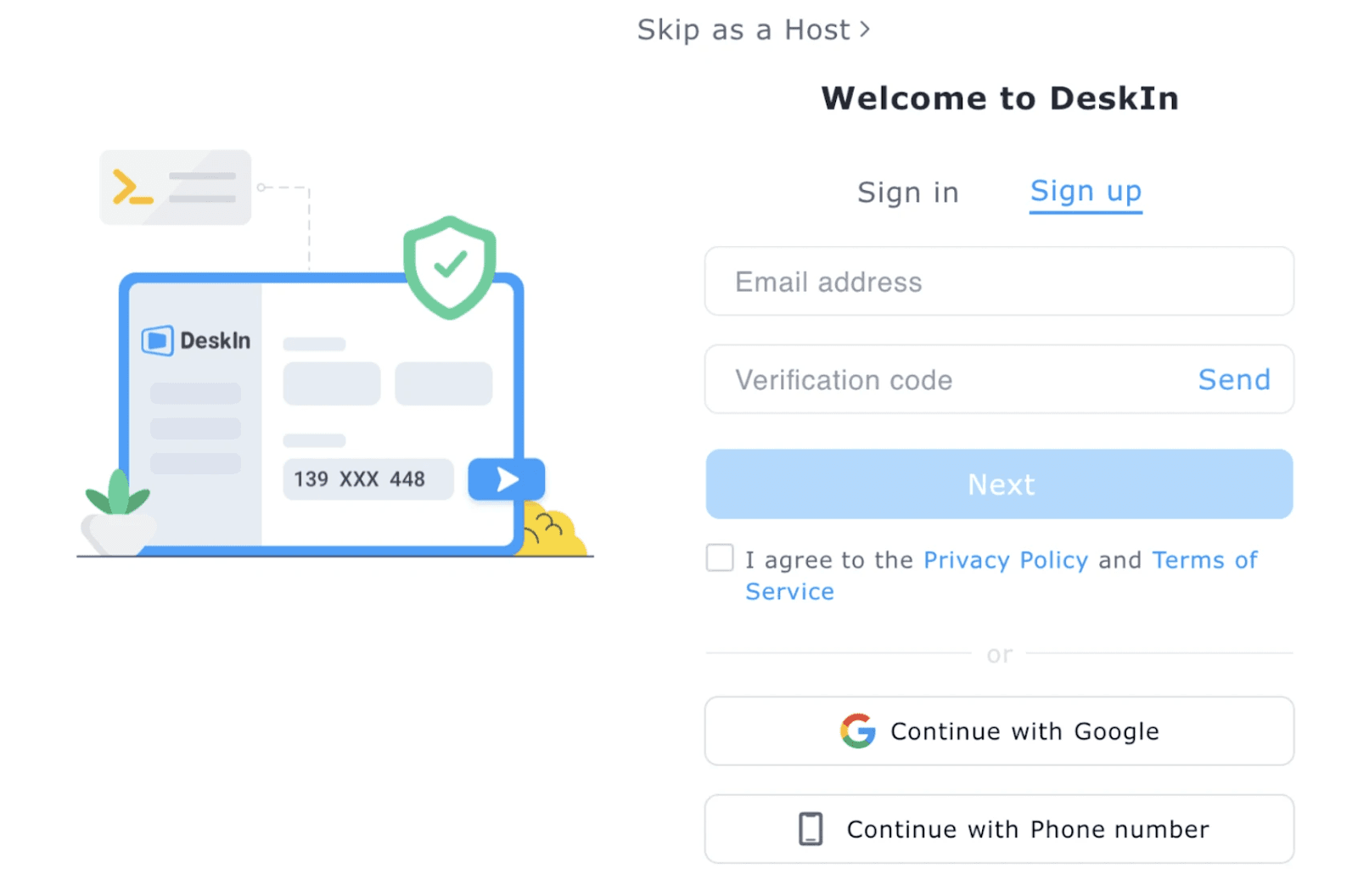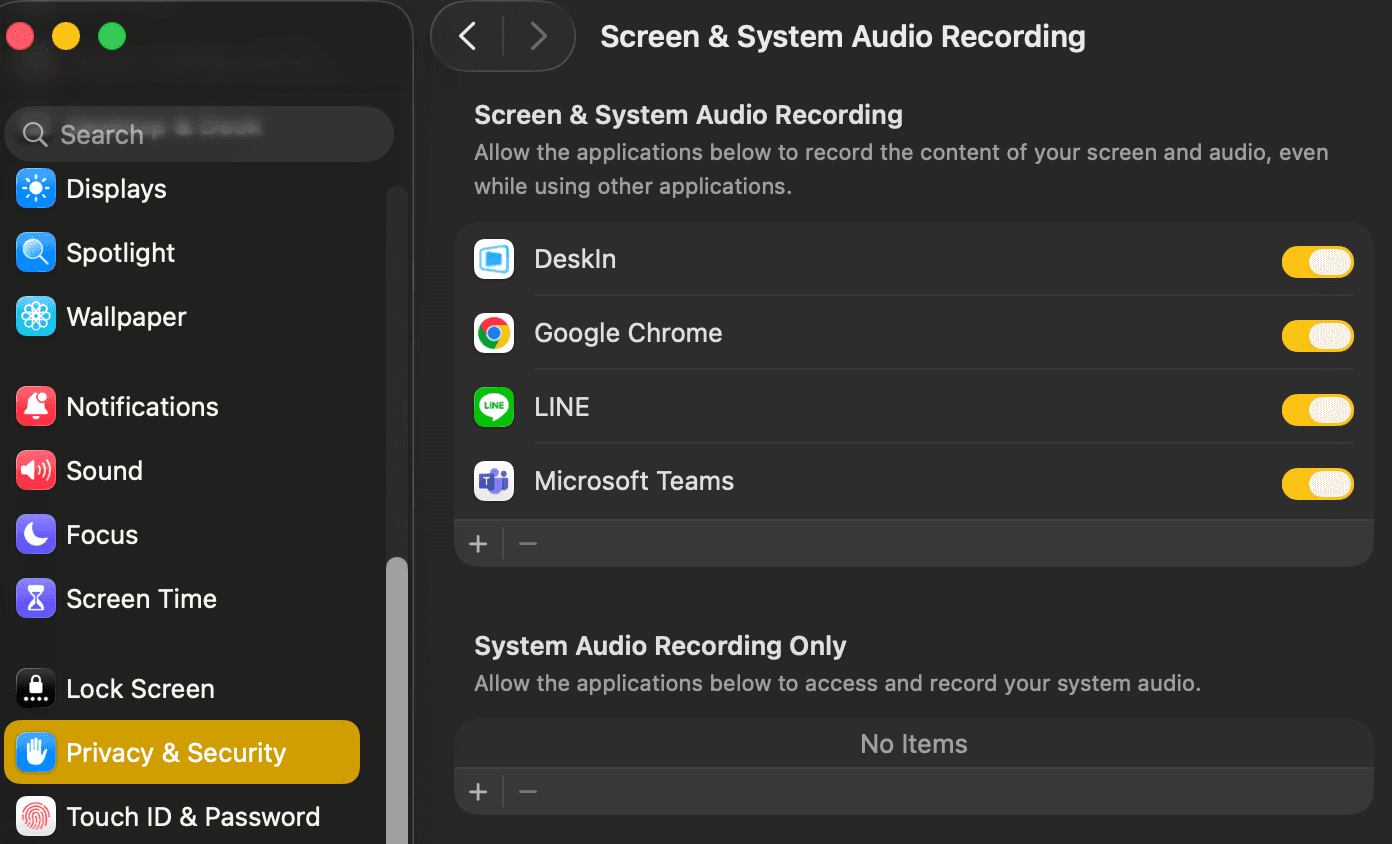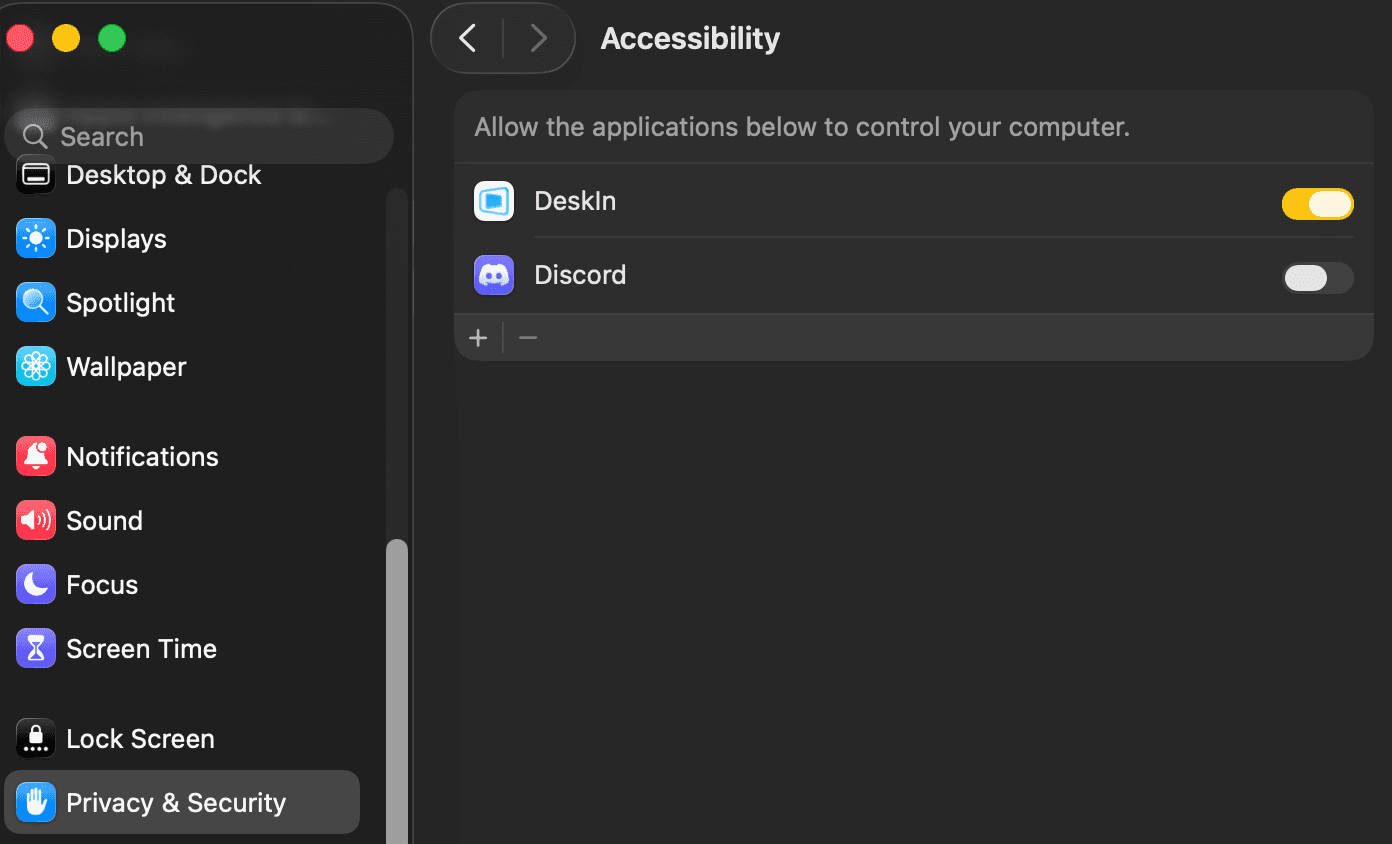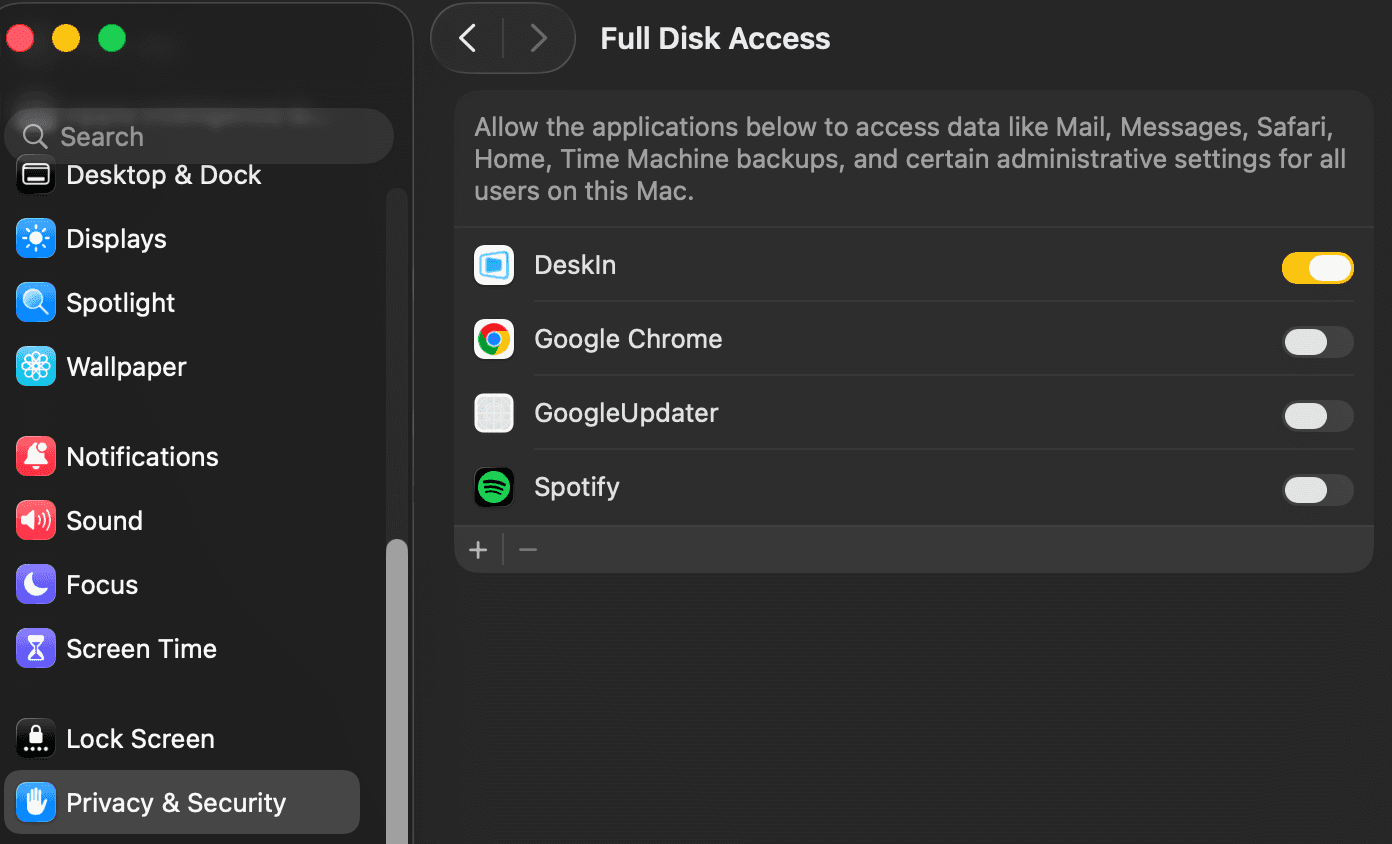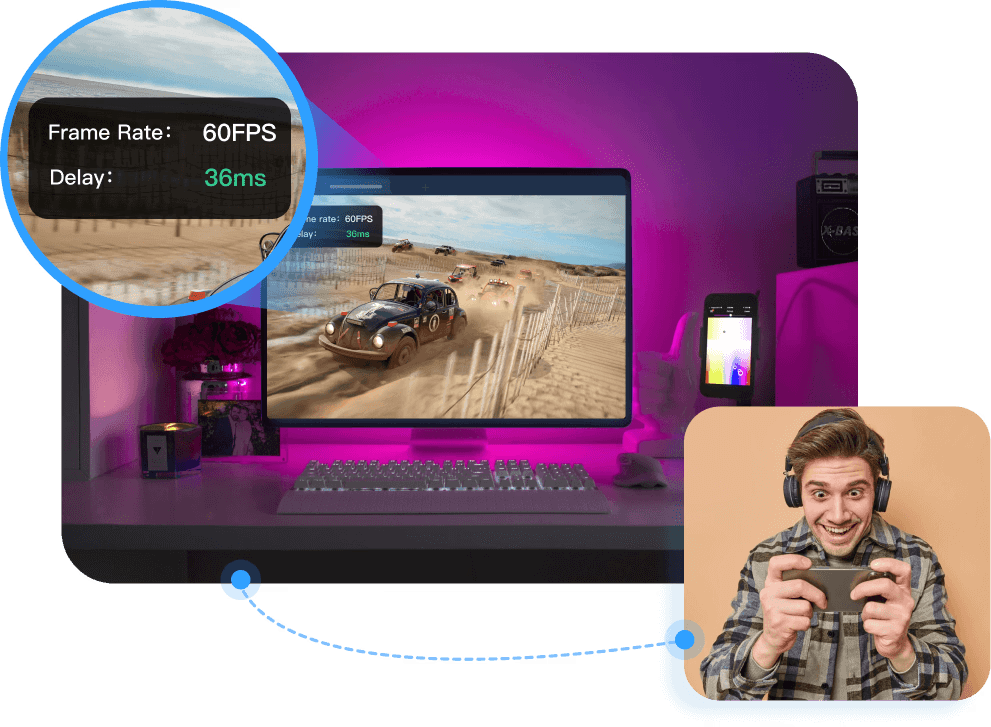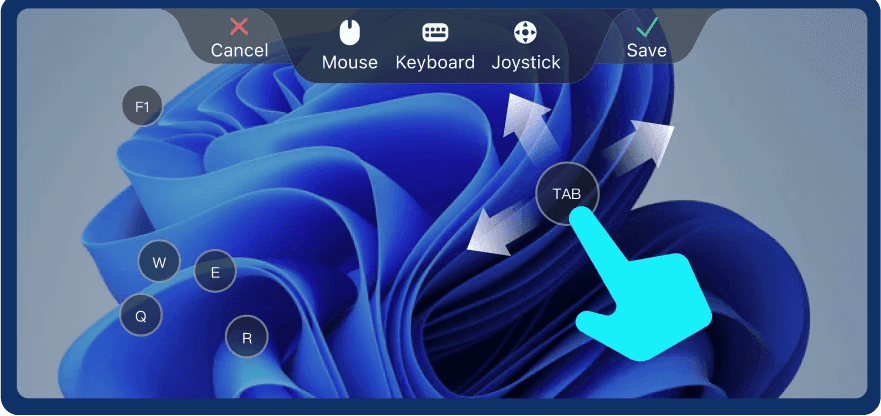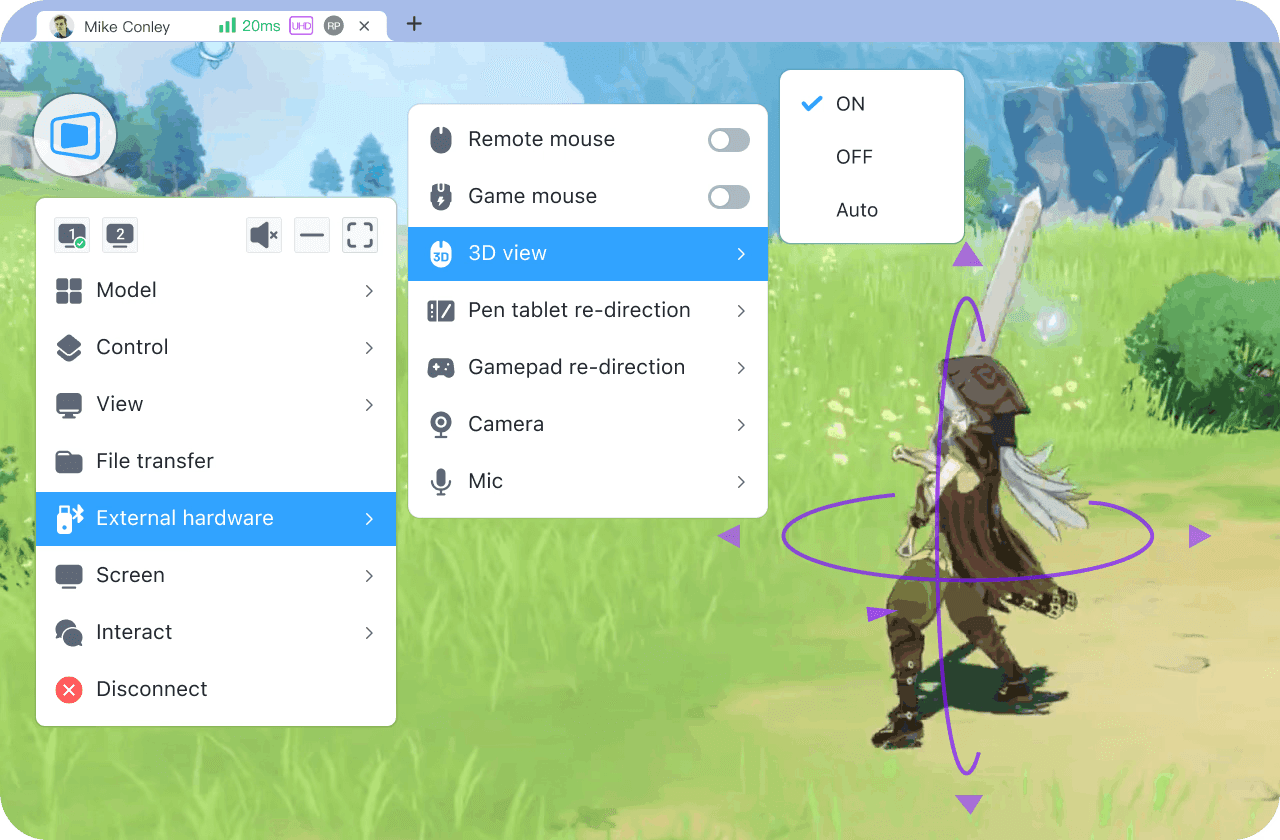3 Phương pháp để thiết lập và chia sẻ màn hình trên Mac (Dễ dàng & Miễn phí)
Chia sẻ màn hình trên Mac có thể cực kỳ hữu ích, cho dù bạn đang hợp tác trong một dự án, khắc phục sự cố kỹ thuật, hoặc đưa ra một bài hướng dẫn nhanh cho đồng nghiệp hoặc bạn bè. Nhưng nếu bạn mới sử dụng macOS hoặc chuyển từ một hệ thống khác, việc tìm ra cách bắt đầu chia sẻ màn hình có thể gây nhầm lẫn.
Hướng dẫn này sẽ dẫn bạn qua 3 cách dễ nhất cùng với cách khắc phục lỗi phổ thông, để chia sẻ màn hình của bạn trên MacBook Air, MacBook Pro, hoặc iMac mà không cần kiến thức kỹ thuật. Từ các công cụ tích hợp đến các tùy chọn bên thứ ba thông minh như DeskIn, bạn sẽ tìm thấy phương pháp phù hợp nhất với nhu cầu của mình.
👀 Thêm thông tin về Chia sẻ màn hình trên Mac:
Top 6 Ứng dụng Gương Màn Hình Tốt Nhất năm 2025 [Tùy chọn Miễn phí & Trả phí]
Cách kết nối Mac với PC qua Chia sẻ Màn hình Remote Desktop [3 Cách]
Phương pháp 1. Sử dụng Tính năng Chia sẻ Màn hình Tích hợp Miễn phí của Mac
Nếu bạn cần chia sẻ màn hình Mac của bạn với một Mac khác trên cùng một mạng cục bộ, ứng dụng Chia sẻ Màn hình tích hợp của Apple cung cấp một giải pháp đơn giản và hiệu quả. Nó đặc biệt hữu ích cho hỗ trợ kỹ thuật, hợp tác, hoặc truy cập từ xa trong gia đình hoặc văn phòng, mà không cần phần mềm của bên thứ ba.
Nói vậy, phương pháp này chỉ hoạt động Mac-to-Mac và yêu cầu cả hai thiết bị phải trên cùng một mạng, điều này làm cho nó lý tưởng cho các tình huống chia sẻ địa phương nhanh chóng. Nếu điều đó phù hợp với tình huống của bạn, hãy làm theo các bước sau để bắt đầu.
Bước 1. Đi đến "Menu Apple > Cài đặt Hệ thống > Chung > Chia sẻ".
Bước 2. Bật "Chia sẻ Màn hình". Dưới "Cho phép truy cập cho", chọn Tất cả người dùng hoặc Chỉ những người dùng này, tùy thuộc vào nhu cầu của bạn.
Bước 3. Trên Mac khác, mở Finder, sau đó đi đến "Mạng", hoặc mở ứng dụng Chia sẻ Màn hình qua Launchpad.
Bước 4. Chọn Mac bạn muốn kết nối, hoặc nhập địa chỉ IP hoặc tên máy chủ của nó, sau đó nhấp vào "Kết nối".
Bước 5. Cuối cùng, tìm máy tính Mac mục tiêu của bạn dưới "Cài đặt > Hiển thị", và phản chiếu màn hình Mac của bạn lên đó.

💡 Những điều cần lưu ý:
Cả hai Mac phải được bật và kết nối với cùng một mạng.
Nếu Tường lửa được bật, hãy chắc chắn rằng nó cho phép các kết nối Chia sẻ Màn hình đến.
Hiệu suất có thể khác nhau tùy thuộc vào tốc độ mạng và tài nguyên hệ thống của bạn.
Phương pháp 2. Chia sẻ Màn hình qua FaceTime trên macOS Mới Nhất
Nếu bạn đang chạy macOS Sonoma hoặc phiên bản mới hơn, FaceTime hiện cung cấp một tính năng chia sẻ màn hình tích hợp để hiển thị màn hình của bạn trong cuộc gọi video, cung cấp một cách dễ dàng để chia sẻ màn hình của bạn trên iMac, MacBook, hoặc bất kỳ thiết bị macOS nào. Nó đặc biệt hữu ích cho các buổi trình diễn nhanh, các cuộc thảo luận hợp tác, hoặc giúp đỡ bạn bè và gia đình khắc phục sự cố, mà không cần bất kỳ ứng dụng hoặc thiết lập nào thêm.
Phương pháp này phù hợp nhất cho việc chia sẻ màn hình Mac tạm thời trong các cuộc trò chuyện thời gian thực, đặc biệt khi nói chuyện với ai đó trên một Mac hoặc thiết bị iOS khác. Tuy nhiên, điều quan trọng là lưu ý rằng chia sẻ màn hình FaceTime không cho phép điều khiển từ xa, và do đó không phù hợp cho hỗ trợ cấp độ IT hoặc truy cập an toàn. Để chia sẻ màn hình của bạn trong cuộc gọi FaceTime, hãy làm theo các bước như sau.
Bước 1. Bắt đầu hoặc tham gia một cuộc gọi FaceTime với người mà bạn muốn chia sẻ màn hình.
Bước 2. Nhấp vào nút "Chia sẻ Màn hình" (một hình chữ nhật với biểu tượng người) trong thanh điều khiển FaceTime.
Bước 3. Chọn "Toàn bộ Màn hình" hoặc "Cửa sổ Cụ thể", tùy thuộc vào những gì bạn muốn hiển thị.
Bước 4. Để ngừng chia sẻ, nhấp vào biểu tượng "chia sẻ màn hình" một lần nữa, hoặc chuyển sang một cửa sổ khác nếu cần.
Xem Thêm:

Phương pháp 3. Sử dụng DeskIn để Chia sẻ Màn hình Dễ dàng và Đa Nền Tảng
Nếu bạn cần chia sẻ màn hình Mac của bạn một cách an toàn qua các mạng hoặc nền tảng khác nhau, hoặc thậm chí có toàn quyền điều khiển từ xa một thiết bị khác, DeskIn là một lựa chọn mạnh mẽ và dễ sử dụng cho các phương pháp truyền thống. Nó được thiết kế cho những người dùng cần nhiều hơn chỉ là chia sẻ màn hình cơ bản, hoàn hảo cho làm việc từ xa, hỗ trợ IT, hoặc hợp tác trực tuyến.
Khác với các công cụ tích hợp của Apple, DeskIn không yêu cầu địa chỉ IP công cộng hoặc chuyển tiếp cổng, nhờ vào khả năng vượt NAT thông minh của nó. Tất cả các kết nối đều được mã hóa đầu đến cuối, đảm bảo dữ liệu của bạn vẫn riêng tư và được bảo vệ. Ngoài chia sẻ màn hình, DeskIn còn hỗ trợ chuyển file, điều khiển thời gian thực, và tính tương thích đa nền tảng, có nghĩa là bạn có thể truy cập từ xa vào Mac từ iPhone, Android, hoặc máy tính Windows, và tận hưởng tất cả các tính năng nâng cao mà không gặp rắc rối.
👍 Các Tính năng Chính của DeskIn:
Không yêu cầu địa chỉ IP công cộng - Kết nối dễ dàng mà không cần cấu hình cổng mạng hoặc tường lửa.
Mã hóa đầu đến cuối - Tất cả các phiên chia sẻ màn hình đều được mã hóa an toàn để bảo vệ dữ liệu nhạy cảm.
Tính tương thích đa nền tảng - Có sẵn trên macOS, Windows, Linux, iOS, và Android.
Hơn cả Chia sẻ Màn hình - Hỗ trợ điều khiển từ xa, chuyển file, và hợp tác thời gian thực.
Phương pháp Truy cập Đơn giản - Kết nối bằng mã truy cập tạm thời hoặc đặt mật khẩu tùy chỉnh cho các kết nối thường xuyên.
Dưới đây là cách chia sẻ màn hình Mac một cách an toàn, và thậm chí điều khiển từ xa máy tính Mac khác của bạn với DeskIn.
Bước 1. Tải xuống và cài đặt ứng dụng DeskIn trên cả hai thiết bị máy chủ (chia sẻ) và người xem (điều khiển).
Bước 2. Đăng ký hoặc đăng nhập vào tài khoản DeskIn của bạn.

Bước 3. Trên thiết bị máy chủ (Mac), tạo một mã kết nối tạm thời hoặc đặt mật khẩu truy cập vĩnh viễn.
Bước 4. Trên thiết bị người xem, nhập mã hoặc thông tin xác thực, và bạn sẽ ngay lập tức có quyền truy cập vào màn hình chia sẻ, với quyền kiểm soát tùy chọn.

Bất kể bạn đang hỗ trợ một khách hàng, hợp tác trong một dự án, hoặc quản lý một thiết lập máy tính để bàn từ xa, DeskIn cung cấp một trải nghiệm chia sẻ màn hình an toàn, mượt mà và hiệu quả cho tất cả các tình huống.
Khắc phục sự cố: Tại sao Chia sẻ Màn hình trên Mac Có thể Không Hoạt Động
Trong quá trình sử dụng, bạn có thể gặp phải một số vấn đề, như chia sẻ màn hình Mac không hoạt động, hoặc không thể chia sẻ Mac của bạn. Dù bạn đang sử dụng ứng dụng Chia sẻ Màn hình tích hợp hay cố gắng chia sẻ trong cuộc gọi FaceTime, có một số lý do phổ biến tại sao nó có thể không hoạt động như mong đợi.
Dưới đây là cách xác định và sửa các vấn đề thường gặp nhất:
Các thiết bị không cùng mạng: Ứng dụng Chia sẻ Màn hình tích hợp chỉ hoạt động khi cả hai Mac được kết nối với cùng một mạng cục bộ. Nếu bạn đang cố gắng kết nối từ xa, phương pháp này sẽ không có hiệu lực.
Tường lửa đang chặn các cổng RDP hoặc VNC: Các tường lửa hoặc cài đặt bảo mật mạng của macOS có thể chặn các cổng được sử dụng để chia sẻ màn hình. Đảm bảo rằng cổng 5900 (VNC) được phép thông qua tường lửa của bạn.
Quyền chia sẻ màn hình không được bật: Đi đến Cài đặt Hệ thống > Chung > Chia sẻ, và đảm bảo Chia sẻ Màn hình được bật. Đồng thời, xác minh rằng các người dùng đúng được ủy quyền trong phần "Cho phép truy cập cho".
Tài khoản người dùng thiếu quyền truy cập: Nếu người dùng đang cố gắng kết nối không được cấp phép trên Mac máy chủ, việc chia sẻ màn hình sẽ không khởi động. Bạn có thể cần thêm họ vào danh sách được phê duyệt.
Các phiên bản macOS không tương thích hoặc lỗi thời: Một số tính năng, như chia sẻ màn hình FaceTime, chỉ có sẵn trên macOS Sonoma và mới hơn. Nếu một thiết bị đang chạy phiên bản cũ hơn, các vấn đề tương thích có thể xảy ra.
📌 Mẹo: Nếu bạn cần chia sẻ màn hình giữa các mạng khác nhau hoặc qua các nền tảng, hãy xem xét sử dụng DeskIn. Nó không yêu cầu cả hai thiết bị phải trên cùng một mạng và tự động xử lý việc vượt tường lửa/NAT. Với mã hóa đầu đến cuối và hỗ trợ đa nền tảng, đây là một giải pháp đáng tin cậy khi các công cụ macOS gốc không đủ.
Tại sao bạn có thể cần chia sẻ màn hình trên Mac từ xa
Chia sẻ màn hình không chỉ là một tính năng công nghệ cao; nó là một công cụ thực tiễn giúp cho việc hợp tác hàng ngày trở nên dễ dàng hơn. Cho dù bạn đang làm việc từ nhà, giúp đỡ một thành viên trong gia đình khắc phục sự cố trên Mac, hay tổ chức một buổi đào tạo trực tuyến, chia sẻ màn hình cho phép người khác thấy chính xác những gì đang diễn ra trên màn hình của bạn theo thời gian thực.
Dưới đây là một số tình huống phổ biến mà chia sẻ màn hình trên Mac có thể phát huy tác dụng:
Thuyết trình từ xa cho khách hàng hoặc đồng đội.
Hỗ trợ kỹ thuật trực tiếp khi ai đó cần hướng dẫn bạn một vấn đề (hoặc ngược lại).
Lớp học hoặc buổi đào tạo trực tuyến mà giải thích bằng hình ảnh là rất quan trọng.
Chỉnh sửa tài liệu hoặc xem xét thiết kế hợp tác mà được lợi từ các hình ảnh chia sẻ.
Kết luận
Tóm lại, chia sẻ màn hình trên Mac có thể dễ dàng thực hiện bằng cách sử dụng ứng dụng Chia sẻ Màn hình tích hợp cho các mạng cục bộ, FaceTime cho việc chia sẻ tạm thời nhanh chóng, hoặc DeskIn cho sự hợp tác an toàn và đa nền tảng. Để chia sẻ màn hình một cách mượt mà và an toàn, DeskIn cung cấp giải pháp tốt nhất, đặc biệt khi làm việc từ xa hoặc qua các thiết bị khác nhau. Chọn phương pháp phù hợp nhất với nhu cầu của bạn, và để nâng cao độ an toàn và linh hoạt, hãy xem xét tải DeskIn cho việc điều khiển máy tính từ xa và chia sẻ màn hình!
3 Phương pháp để thiết lập và chia sẻ màn hình trên Mac (Dễ dàng & Miễn phí)
Chia sẻ màn hình trên Mac có thể cực kỳ hữu ích, cho dù bạn đang hợp tác trong một dự án, khắc phục sự cố kỹ thuật, hoặc đưa ra một bài hướng dẫn nhanh cho đồng nghiệp hoặc bạn bè. Nhưng nếu bạn mới sử dụng macOS hoặc chuyển từ một hệ thống khác, việc tìm ra cách bắt đầu chia sẻ màn hình có thể gây nhầm lẫn.
Hướng dẫn này sẽ dẫn bạn qua 3 cách dễ nhất cùng với cách khắc phục lỗi phổ thông, để chia sẻ màn hình của bạn trên MacBook Air, MacBook Pro, hoặc iMac mà không cần kiến thức kỹ thuật. Từ các công cụ tích hợp đến các tùy chọn bên thứ ba thông minh như DeskIn, bạn sẽ tìm thấy phương pháp phù hợp nhất với nhu cầu của mình.
👀 Thêm thông tin về Chia sẻ màn hình trên Mac:
Top 6 Ứng dụng Gương Màn Hình Tốt Nhất năm 2025 [Tùy chọn Miễn phí & Trả phí]
Cách kết nối Mac với PC qua Chia sẻ Màn hình Remote Desktop [3 Cách]
Phương pháp 1. Sử dụng Tính năng Chia sẻ Màn hình Tích hợp Miễn phí của Mac
Nếu bạn cần chia sẻ màn hình Mac của bạn với một Mac khác trên cùng một mạng cục bộ, ứng dụng Chia sẻ Màn hình tích hợp của Apple cung cấp một giải pháp đơn giản và hiệu quả. Nó đặc biệt hữu ích cho hỗ trợ kỹ thuật, hợp tác, hoặc truy cập từ xa trong gia đình hoặc văn phòng, mà không cần phần mềm của bên thứ ba.
Nói vậy, phương pháp này chỉ hoạt động Mac-to-Mac và yêu cầu cả hai thiết bị phải trên cùng một mạng, điều này làm cho nó lý tưởng cho các tình huống chia sẻ địa phương nhanh chóng. Nếu điều đó phù hợp với tình huống của bạn, hãy làm theo các bước sau để bắt đầu.
Bước 1. Đi đến "Menu Apple > Cài đặt Hệ thống > Chung > Chia sẻ".
Bước 2. Bật "Chia sẻ Màn hình". Dưới "Cho phép truy cập cho", chọn Tất cả người dùng hoặc Chỉ những người dùng này, tùy thuộc vào nhu cầu của bạn.
Bước 3. Trên Mac khác, mở Finder, sau đó đi đến "Mạng", hoặc mở ứng dụng Chia sẻ Màn hình qua Launchpad.
Bước 4. Chọn Mac bạn muốn kết nối, hoặc nhập địa chỉ IP hoặc tên máy chủ của nó, sau đó nhấp vào "Kết nối".
Bước 5. Cuối cùng, tìm máy tính Mac mục tiêu của bạn dưới "Cài đặt > Hiển thị", và phản chiếu màn hình Mac của bạn lên đó.

💡 Những điều cần lưu ý:
Cả hai Mac phải được bật và kết nối với cùng một mạng.
Nếu Tường lửa được bật, hãy chắc chắn rằng nó cho phép các kết nối Chia sẻ Màn hình đến.
Hiệu suất có thể khác nhau tùy thuộc vào tốc độ mạng và tài nguyên hệ thống của bạn.
Phương pháp 2. Chia sẻ Màn hình qua FaceTime trên macOS Mới Nhất
Nếu bạn đang chạy macOS Sonoma hoặc phiên bản mới hơn, FaceTime hiện cung cấp một tính năng chia sẻ màn hình tích hợp để hiển thị màn hình của bạn trong cuộc gọi video, cung cấp một cách dễ dàng để chia sẻ màn hình của bạn trên iMac, MacBook, hoặc bất kỳ thiết bị macOS nào. Nó đặc biệt hữu ích cho các buổi trình diễn nhanh, các cuộc thảo luận hợp tác, hoặc giúp đỡ bạn bè và gia đình khắc phục sự cố, mà không cần bất kỳ ứng dụng hoặc thiết lập nào thêm.
Phương pháp này phù hợp nhất cho việc chia sẻ màn hình Mac tạm thời trong các cuộc trò chuyện thời gian thực, đặc biệt khi nói chuyện với ai đó trên một Mac hoặc thiết bị iOS khác. Tuy nhiên, điều quan trọng là lưu ý rằng chia sẻ màn hình FaceTime không cho phép điều khiển từ xa, và do đó không phù hợp cho hỗ trợ cấp độ IT hoặc truy cập an toàn. Để chia sẻ màn hình của bạn trong cuộc gọi FaceTime, hãy làm theo các bước như sau.
Bước 1. Bắt đầu hoặc tham gia một cuộc gọi FaceTime với người mà bạn muốn chia sẻ màn hình.
Bước 2. Nhấp vào nút "Chia sẻ Màn hình" (một hình chữ nhật với biểu tượng người) trong thanh điều khiển FaceTime.
Bước 3. Chọn "Toàn bộ Màn hình" hoặc "Cửa sổ Cụ thể", tùy thuộc vào những gì bạn muốn hiển thị.
Bước 4. Để ngừng chia sẻ, nhấp vào biểu tượng "chia sẻ màn hình" một lần nữa, hoặc chuyển sang một cửa sổ khác nếu cần.
Xem Thêm:

Phương pháp 3. Sử dụng DeskIn để Chia sẻ Màn hình Dễ dàng và Đa Nền Tảng
Nếu bạn cần chia sẻ màn hình Mac của bạn một cách an toàn qua các mạng hoặc nền tảng khác nhau, hoặc thậm chí có toàn quyền điều khiển từ xa một thiết bị khác, DeskIn là một lựa chọn mạnh mẽ và dễ sử dụng cho các phương pháp truyền thống. Nó được thiết kế cho những người dùng cần nhiều hơn chỉ là chia sẻ màn hình cơ bản, hoàn hảo cho làm việc từ xa, hỗ trợ IT, hoặc hợp tác trực tuyến.
Khác với các công cụ tích hợp của Apple, DeskIn không yêu cầu địa chỉ IP công cộng hoặc chuyển tiếp cổng, nhờ vào khả năng vượt NAT thông minh của nó. Tất cả các kết nối đều được mã hóa đầu đến cuối, đảm bảo dữ liệu của bạn vẫn riêng tư và được bảo vệ. Ngoài chia sẻ màn hình, DeskIn còn hỗ trợ chuyển file, điều khiển thời gian thực, và tính tương thích đa nền tảng, có nghĩa là bạn có thể truy cập từ xa vào Mac từ iPhone, Android, hoặc máy tính Windows, và tận hưởng tất cả các tính năng nâng cao mà không gặp rắc rối.
👍 Các Tính năng Chính của DeskIn:
Không yêu cầu địa chỉ IP công cộng - Kết nối dễ dàng mà không cần cấu hình cổng mạng hoặc tường lửa.
Mã hóa đầu đến cuối - Tất cả các phiên chia sẻ màn hình đều được mã hóa an toàn để bảo vệ dữ liệu nhạy cảm.
Tính tương thích đa nền tảng - Có sẵn trên macOS, Windows, Linux, iOS, và Android.
Hơn cả Chia sẻ Màn hình - Hỗ trợ điều khiển từ xa, chuyển file, và hợp tác thời gian thực.
Phương pháp Truy cập Đơn giản - Kết nối bằng mã truy cập tạm thời hoặc đặt mật khẩu tùy chỉnh cho các kết nối thường xuyên.
Dưới đây là cách chia sẻ màn hình Mac một cách an toàn, và thậm chí điều khiển từ xa máy tính Mac khác của bạn với DeskIn.
Bước 1. Tải xuống và cài đặt ứng dụng DeskIn trên cả hai thiết bị máy chủ (chia sẻ) và người xem (điều khiển).
Bước 2. Đăng ký hoặc đăng nhập vào tài khoản DeskIn của bạn.

Bước 3. Trên thiết bị máy chủ (Mac), tạo một mã kết nối tạm thời hoặc đặt mật khẩu truy cập vĩnh viễn.
Bước 4. Trên thiết bị người xem, nhập mã hoặc thông tin xác thực, và bạn sẽ ngay lập tức có quyền truy cập vào màn hình chia sẻ, với quyền kiểm soát tùy chọn.

Bất kể bạn đang hỗ trợ một khách hàng, hợp tác trong một dự án, hoặc quản lý một thiết lập máy tính để bàn từ xa, DeskIn cung cấp một trải nghiệm chia sẻ màn hình an toàn, mượt mà và hiệu quả cho tất cả các tình huống.
Khắc phục sự cố: Tại sao Chia sẻ Màn hình trên Mac Có thể Không Hoạt Động
Trong quá trình sử dụng, bạn có thể gặp phải một số vấn đề, như chia sẻ màn hình Mac không hoạt động, hoặc không thể chia sẻ Mac của bạn. Dù bạn đang sử dụng ứng dụng Chia sẻ Màn hình tích hợp hay cố gắng chia sẻ trong cuộc gọi FaceTime, có một số lý do phổ biến tại sao nó có thể không hoạt động như mong đợi.
Dưới đây là cách xác định và sửa các vấn đề thường gặp nhất:
Các thiết bị không cùng mạng: Ứng dụng Chia sẻ Màn hình tích hợp chỉ hoạt động khi cả hai Mac được kết nối với cùng một mạng cục bộ. Nếu bạn đang cố gắng kết nối từ xa, phương pháp này sẽ không có hiệu lực.
Tường lửa đang chặn các cổng RDP hoặc VNC: Các tường lửa hoặc cài đặt bảo mật mạng của macOS có thể chặn các cổng được sử dụng để chia sẻ màn hình. Đảm bảo rằng cổng 5900 (VNC) được phép thông qua tường lửa của bạn.
Quyền chia sẻ màn hình không được bật: Đi đến Cài đặt Hệ thống > Chung > Chia sẻ, và đảm bảo Chia sẻ Màn hình được bật. Đồng thời, xác minh rằng các người dùng đúng được ủy quyền trong phần "Cho phép truy cập cho".
Tài khoản người dùng thiếu quyền truy cập: Nếu người dùng đang cố gắng kết nối không được cấp phép trên Mac máy chủ, việc chia sẻ màn hình sẽ không khởi động. Bạn có thể cần thêm họ vào danh sách được phê duyệt.
Các phiên bản macOS không tương thích hoặc lỗi thời: Một số tính năng, như chia sẻ màn hình FaceTime, chỉ có sẵn trên macOS Sonoma và mới hơn. Nếu một thiết bị đang chạy phiên bản cũ hơn, các vấn đề tương thích có thể xảy ra.
📌 Mẹo: Nếu bạn cần chia sẻ màn hình giữa các mạng khác nhau hoặc qua các nền tảng, hãy xem xét sử dụng DeskIn. Nó không yêu cầu cả hai thiết bị phải trên cùng một mạng và tự động xử lý việc vượt tường lửa/NAT. Với mã hóa đầu đến cuối và hỗ trợ đa nền tảng, đây là một giải pháp đáng tin cậy khi các công cụ macOS gốc không đủ.
Tại sao bạn có thể cần chia sẻ màn hình trên Mac từ xa
Chia sẻ màn hình không chỉ là một tính năng công nghệ cao; nó là một công cụ thực tiễn giúp cho việc hợp tác hàng ngày trở nên dễ dàng hơn. Cho dù bạn đang làm việc từ nhà, giúp đỡ một thành viên trong gia đình khắc phục sự cố trên Mac, hay tổ chức một buổi đào tạo trực tuyến, chia sẻ màn hình cho phép người khác thấy chính xác những gì đang diễn ra trên màn hình của bạn theo thời gian thực.
Dưới đây là một số tình huống phổ biến mà chia sẻ màn hình trên Mac có thể phát huy tác dụng:
Thuyết trình từ xa cho khách hàng hoặc đồng đội.
Hỗ trợ kỹ thuật trực tiếp khi ai đó cần hướng dẫn bạn một vấn đề (hoặc ngược lại).
Lớp học hoặc buổi đào tạo trực tuyến mà giải thích bằng hình ảnh là rất quan trọng.
Chỉnh sửa tài liệu hoặc xem xét thiết kế hợp tác mà được lợi từ các hình ảnh chia sẻ.
Kết luận
Tóm lại, chia sẻ màn hình trên Mac có thể dễ dàng thực hiện bằng cách sử dụng ứng dụng Chia sẻ Màn hình tích hợp cho các mạng cục bộ, FaceTime cho việc chia sẻ tạm thời nhanh chóng, hoặc DeskIn cho sự hợp tác an toàn và đa nền tảng. Để chia sẻ màn hình một cách mượt mà và an toàn, DeskIn cung cấp giải pháp tốt nhất, đặc biệt khi làm việc từ xa hoặc qua các thiết bị khác nhau. Chọn phương pháp phù hợp nhất với nhu cầu của bạn, và để nâng cao độ an toàn và linh hoạt, hãy xem xét tải DeskIn cho việc điều khiển máy tính từ xa và chia sẻ màn hình!

Play x Work
All at Once
DeskIn Remote Game
only $14.32 USD 🎉 Limited on July 16-31
Add promo code: deskinsummer1





